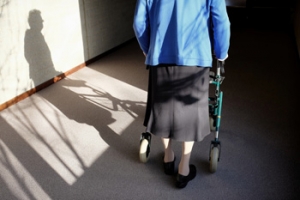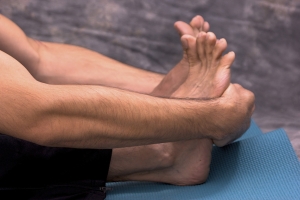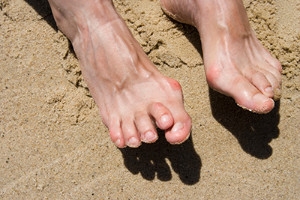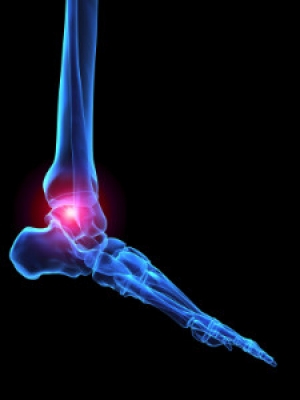
Foot Conditions That May Affect the Elderly
 Many feet can develop problems, especially those of the elderly after supporting their own body weight for their entire lives. Not only have many older feet experienced overuse, but older cells also hold less water, leading to tightened tendons and loosened ligaments. Some foot problems that seniors may experience include bunions, arthritis, heel pain, fungal infections, and hammertoes. Inactive seniors can experience vascular disease and foot problems related to diabetes as well. In order to prevent these issues and allow seniors to be active, the assistance of a podiatrist may be needed. A podiatrist will be able to provide preventative measures as well as treatment methods to already present injuries. If you or a loved one is experiencing foot pain, please speak with a podiatrist for professional care.
Many feet can develop problems, especially those of the elderly after supporting their own body weight for their entire lives. Not only have many older feet experienced overuse, but older cells also hold less water, leading to tightened tendons and loosened ligaments. Some foot problems that seniors may experience include bunions, arthritis, heel pain, fungal infections, and hammertoes. Inactive seniors can experience vascular disease and foot problems related to diabetes as well. In order to prevent these issues and allow seniors to be active, the assistance of a podiatrist may be needed. A podiatrist will be able to provide preventative measures as well as treatment methods to already present injuries. If you or a loved one is experiencing foot pain, please speak with a podiatrist for professional care.
Proper foot care is something many older adults forget to consider. If you have any concerns about your feet and ankles, contact one of our podiatrists from Princeton Foot and Ankle Associates. Our doctors can provide the care you need to keep you pain-free and on your feet.
The Elderly and Their Feet
As we age we start to notice many changes in our body, but the elder population may not notice them right away. Medical conditions may prevent the elderly to take notice of their foot health right away. Poor vision is a lead contributor to not taking action for the elderly.
Common Conditions
- Neuropathy – can reduce feeling in the feet and can hide many life-threatening medical conditions.
- Reduced flexibility – prevents the ability of proper toenail trimming, and foot cleaning. If left untreated, it may lead to further medical issues.
- Foot sores – amongst the older population can be serious before they are discovered. Some of the problematic conditions they may face are:
- Gouging toenails affecting nearby toe
- Shoes that don’t fit properly
- Pressure sores
- Loss of circulation in legs & feet
- Edema & swelling of feet and ankles
Susceptible Infections
Diabetes and poor circulation can cause general loss of sensitivity over the years, turning a simple cut into a serious issue.
If you have any questions please feel free to contact our offices located in Princeton, and West Windsor, NJ . We offer the newest diagnostic and treatment technologies for all your foot and ankle needs.
Elderly Foot Care
As you grow older, you will start to notice more problems with your feet due to wear and tear. This may also happen because the skin will start to become thin and lose elasticity. Some signs of aging feet are regular aches and pains, bunion development, and clawed toes.
Fortunately, there are ways you can improve comfort, relieve pain, and maintain mobility in your feet. One of the best ways to deal with aging feet is to exercise. If you keep active, your muscles will become toned which will then strengthen the arches in the foot and stimulate blood circulation.
It is important that you practice proper foot care to protect your aging feet. You should wash your feet in warm water on an everyday basis. Afterward, the feet need to be dried well and it is important to dry between the toes. Your toenails should be trimmed and kept under control; nails that are poorly cut may become ingrown. At the end of each day, performing an inspection of your feet will allow you to detect any ailments in their early stages.
As you grow older, it becomes more important that you wear comfortable shoes. Your shoes should be secure, and they should provide decent arch support. If you are looking to buy a new pair of shoes, it is best to look for a pair that are made from a breathable material. It is also helpful to have shoes that have a bit of extra room at the top of the shoe, especially if you suffer from swollen feet.
The most common foot problems that elderly people will encounter are bunions, calluses, corns, hammertoes, heel pain, and foot problems related to diabetes. Some other issues include arch pain, tarsal tunnel syndrome, Achilles tendonitis, and Morton’s neuroma
An annual foot examination is a great way for you to ensure that you do not have any serious health problems with your feet. You should talk to a podiatrist about the available treatment options for whichever foot issue you are dealing with.
How Can an Achilles Tendon Injury Occur?
 The tissue that connects the heel to the calf muscles is referred to as the Achilles tendon. This tendon is responsible for the ability to walk, run, and jump, and these activities may be difficult to perform if it becomes injured or torn. This type of injury can occur as a result of exercising on an uneven surface or from wearing shoes that do not fit properly. Additionally, if the calf muscles are tight, the Achilles tendon may endure stress, and this can possibly lead to a rupture. Common symptoms many patients experience can include severe pain in the calf difficulty in pointing and flexing the affected foot. If you have endured an injury to the Achilles tendon, it is advised that you consult with a podiatrist who can help you with proper treatment options.
The tissue that connects the heel to the calf muscles is referred to as the Achilles tendon. This tendon is responsible for the ability to walk, run, and jump, and these activities may be difficult to perform if it becomes injured or torn. This type of injury can occur as a result of exercising on an uneven surface or from wearing shoes that do not fit properly. Additionally, if the calf muscles are tight, the Achilles tendon may endure stress, and this can possibly lead to a rupture. Common symptoms many patients experience can include severe pain in the calf difficulty in pointing and flexing the affected foot. If you have endured an injury to the Achilles tendon, it is advised that you consult with a podiatrist who can help you with proper treatment options.
Achilles tendon injuries need immediate attention to avoid future complications. If you have any concerns, contact one of our podiatrists of Princeton Foot and Ankle Associates. Our doctors can provide the care you need to keep you pain-free and on your feet.
What Is the Achilles Tendon?
The Achilles tendon is a tendon that connects the lower leg muscles and calf to the heel of the foot. It is the strongest tendon in the human body and is essential for making movement possible. Because this tendon is such an integral part of the body, any injuries to it can create immense difficulties and should immediately be presented to a doctor.
What Are the Symptoms of an Achilles Tendon Injury?
There are various types of injuries that can affect the Achilles tendon. The two most common injuries are Achilles tendinitis and ruptures of the tendon.
Achilles Tendinitis Symptoms
- Inflammation
- Dull to severe pain
- Increased blood flow to the tendon
- Thickening of the tendon
Rupture Symptoms
- Extreme pain and swelling in the foot
- Total immobility
Treatment and Prevention
Achilles tendon injuries are diagnosed by a thorough physical evaluation, which can include an MRI. Treatment involves rest, physical therapy, and in some cases, surgery. However, various preventative measures can be taken to avoid these injuries, such as:
- Thorough stretching of the tendon before and after exercise
- Strengthening exercises like calf raises, squats, leg curls, leg extensions, leg raises, lunges, and leg presses
If you have any questions please feel free to contact our offices located in Princeton, and West Windsor, NJ . We offer the newest diagnostic tools and technology to treat your foot and ankle needs.
What are Achilles Tendon Injuries
The Achilles tendon is the strongest tendon in the human body. Its purpose is to connect the lower leg muscles and calf to the heel of the foot. This tendon is responsible for facilitating all types of movement, like walking and running. This tendon provides an enormous amount of mobility for the body. Any injuries inflicted to this tissue should be immediately brought up with a physician to prevent further damage.
The most common injuries that can trouble the Achilles tendon are tendon ruptures and Achilles tendinitis. Achilles tendinitis is the milder of the two injuries. It can be recognized by the following symptoms: inflammation, dull-to-severe pain, increased blood flow to the tendon, thickening of the tendon, and slower movement time. Tendinitis can be treated via several methods and is often diagnosed by an MRI.
An Achilles tendon rupture is trickier to heal, and is by far the most painful injury. It is caused by the tendon ripping or completely snapping. The results are immediate and absolutely devastating, and will render the patient immobile. If a rupture or tear occurs, operative and non-operative methods are available. Once the treatment begins, depending on the severity of the injury, recovery time for these types of issues can take up to a year.
Simple preventative measures can be taken as a means to avoid both injuries. Prior to any movement, taking a few minutes to stretch out the tendon is a great way to stimulate the tissue. Calf raises, squats, leg curls, leg extensions, leg raises, lunges, and leg presses are all suggested ways to help strengthen the lower legs and promote Achilles tendon health.
Many problems arise among athletes and people who overexert themselves while exercising. Problems can also happen among those who do not warm up properly before beginning an activity. Proper, comfortable shoes that fit correctly can also decrease tendon injuries. Some professionals also suggest that when exercising, you should make sure that the floor you are on is cushioned or has a mat. This will relieve pressure on the heels. A healthy diet will also increase tendon health.
It is very important to seek out a podiatrist if you believe you have an injury in the Achilles region. Further damage could result in severe complications that would make being mobile difficult, if not impossible.
How Can I Stretch My Feet?
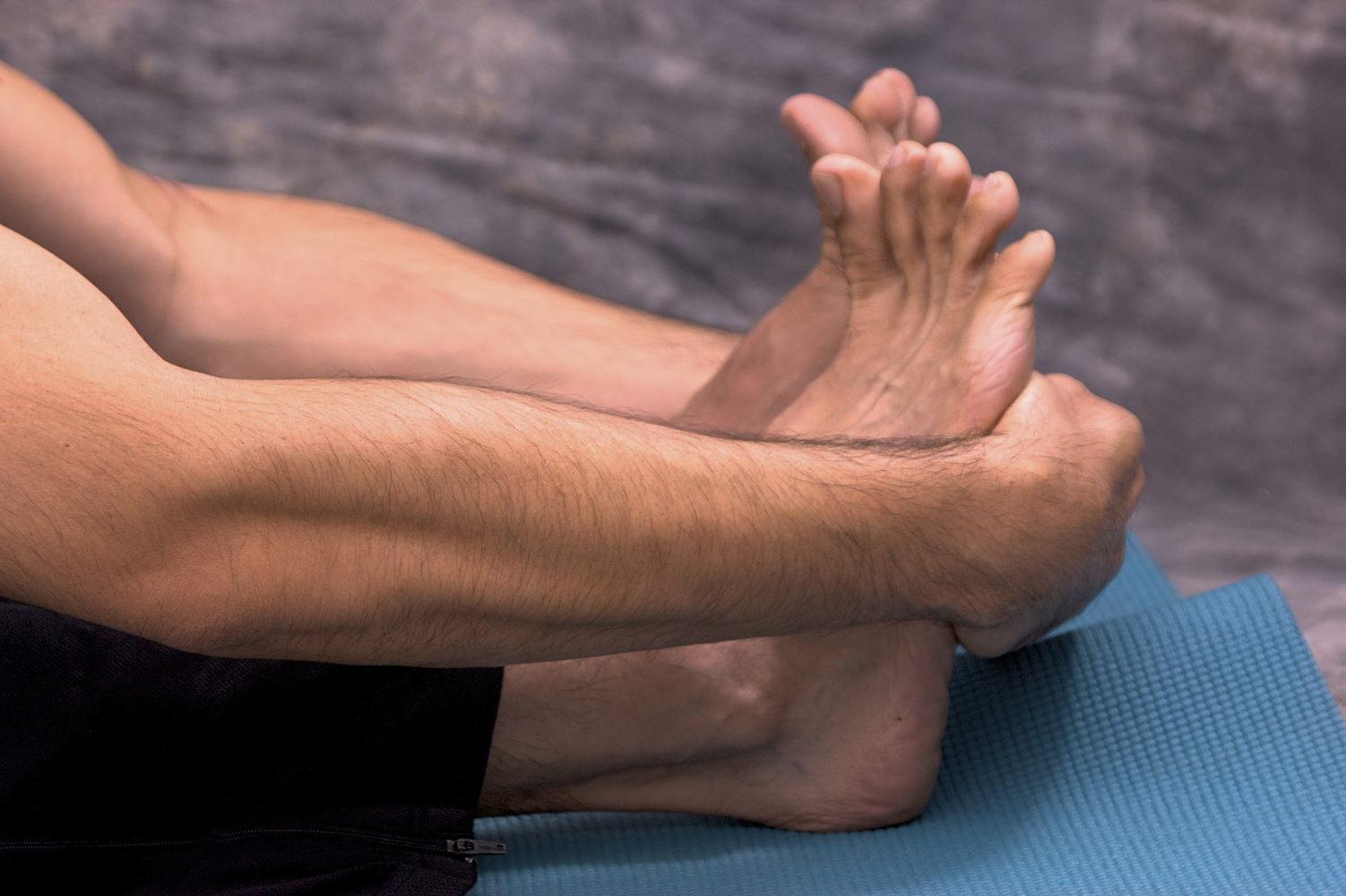 The feet endure the weight of the body, and many people experience aches and pains in their feet as a result from standing or walking for long periods of time. Injuries may be prevented and the feet can generally feel better when foot stretches are performed. An effective stretch is referred to as a towel stretch. This is practiced by placing a towel around your toes while seated with your legs straight. A gentle stretch can be obtained when the towel is slowly pulled towards you. An Achilles tendon stretch is performed by standing on a step, and carefully lowering one heel at a time. The toes can become stronger when they are spread apart while sitting in a chair, and releasing after several seconds. If you would like additional information about the benefits of stretching your feet, please consult with a podiatrist.
The feet endure the weight of the body, and many people experience aches and pains in their feet as a result from standing or walking for long periods of time. Injuries may be prevented and the feet can generally feel better when foot stretches are performed. An effective stretch is referred to as a towel stretch. This is practiced by placing a towel around your toes while seated with your legs straight. A gentle stretch can be obtained when the towel is slowly pulled towards you. An Achilles tendon stretch is performed by standing on a step, and carefully lowering one heel at a time. The toes can become stronger when they are spread apart while sitting in a chair, and releasing after several seconds. If you would like additional information about the benefits of stretching your feet, please consult with a podiatrist.
Stretching the feet is a great way to prevent injuries. If you have any concerns with your feet consult with one of our podiatrists from Princeton Foot and Ankle Associates. Our doctors will assess your condition and provide you with quality foot and ankle treatment.
Stretching the Feet
Being the backbone of the body, the feet carry your entire weight and can easily become overexerted, causing cramps and pain. As with any body part, stretching your feet can serve many benefits. From increasing flexibility to even providing some pain relief, be sure to give your feet a stretch from time to time. This is especially important for athletes or anyone performing aerobic exercises, but anyone experiencing foot pain or is on their feet constantly should also engage in this practice.
Great ways to stretch your feet:
- Crossing one leg over the others and carefully pull your toes back. Do 10-20 repetitions and repeat the process for each foot
- Face a wall with your arms out and hands flat against the wall. Step back with one foot and keep it flat on the floor while moving the other leg forward. Lean towards the wall until you feel a stretch. Hold for 30 seconds and perform 10 repetitions for each foot
- Be sure not to overextend or push your limbs too hard or you could risk pulling or straining your muscle
Individuals who tend to their feet by regular stretching every day should be able to minimize foot pain and prevent new problems from arising.
If you have any questions, please feel free to contact our offices located in Princeton, and West Windsor, NJ . We offer the newest diagnostic and treatment technologies for all your foot care needs.
How to Stretch Your Feet
Your feet endure a great amount of stress each day from constantly allowing us to move around. It is important to stretch your feet to help prevent them from becoming injured. Your toes may easily deform into unhealthful positions if they are not stretched.
One of the most common reasons for toe deformities are the shoes you may be wearing. Shoes that are too tight may fold and shift the toes out of place. Heeled shoes may also push your toes upward. Forcing your toes into an unnatural position which may cause the muscles to tighten and prevent them from reverting to normal length. Another common reason is improper use of foot muscles. Many people fail to use the muscles in their feet or toes when they walk. Lastly, the positioning of your feet while walking may also cause toe deformities. If you walk with your feet facing outward, your “push-off” phase is on the side of your big toe instead of the bottom of your foot. This may cause the big toe to eventually tighten into a new shifted position.
There are many reasons why stretching your toes may be helpful. One reason is that healthy spacing may aid in avoiding calluses and other injuries that are caused by rubbing. Stretching will also prevent you from developing toes that curl, hammertoes, or bunions.
A great way to stretch your toes is to place them in your hands and bend them all downward; this will help you stretch the top of your foot. Next, you should repeat this process but instead bend them upward enough to feel a nice stretch in the bottom of your foot. You should then try to pull each toe apart from the next and pull any toes that are bent upward until they are back downward.
If you are looking to practice stretching your entire foot, you can try a towel stretch. This is done by sitting on the floor with your legs in front of you. Take a towel and wrap it around your toes. Afterward, pull the towel toward you with your toes and hold this position for 15 to 30 seconds before releasing. Practice this stretch for three sets. Another stretch your feet are towel lifts. This is done by sitting in a chair and trying to pick a towel up from the ground with your toes. Try lifting the towel with your little toes for five sets before switching feet.
If you are an athlete, or exercise often, it is especially important for you to practice stretching your feet. Those who suffer from foot pain caused by poor footwear, plantar fasciitis, or long hours of standing at work may also benefit from foot exercises.
How Does Hammertoe Occur?
 The second and third toes may be impacted by the medical condition that is known as hammertoe. The toe bends at the joint in an upward position, and often resembles a hammer. It is considered to be a deformity, and in severe cases, surgery may be necessary to permanently straighten the toes.There are two stages of hammertoe. When this condition is first noticed, the joints can be flexible, and relief may be found when the correct shoes are worn. Additionally, there are specific stretches that can be performed which may help to strengthen the toes. When the condition becomes more severe, it is referred to as rigid hammertoe, and the joints are unable to move. A common reason why this condition may develop can consist of wearing shoes that do not have adequate room for the toes to move freely in. Additionally, genetic factors may lead to developing hammertoe. Please consult with a podiatrist who can properly diagnose this ailment, and suggest treatment options that are correct for you.
The second and third toes may be impacted by the medical condition that is known as hammertoe. The toe bends at the joint in an upward position, and often resembles a hammer. It is considered to be a deformity, and in severe cases, surgery may be necessary to permanently straighten the toes.There are two stages of hammertoe. When this condition is first noticed, the joints can be flexible, and relief may be found when the correct shoes are worn. Additionally, there are specific stretches that can be performed which may help to strengthen the toes. When the condition becomes more severe, it is referred to as rigid hammertoe, and the joints are unable to move. A common reason why this condition may develop can consist of wearing shoes that do not have adequate room for the toes to move freely in. Additionally, genetic factors may lead to developing hammertoe. Please consult with a podiatrist who can properly diagnose this ailment, and suggest treatment options that are correct for you.
Hammertoes can be a painful condition to live with. For more information, contact one of our podiatrists of Princeton Foot and Ankle Associates. Our doctors will answer any of your foot- and ankle-related questions.
Hammertoe
Hammertoe is a foot deformity that occurs due to an imbalance in the muscles, tendons, or ligaments that normally hold the toe straight. It can be caused by the type of shoes you wear, your foot structure, trauma, and certain disease processes.
Symptoms
- Painful and/or difficult toe movement
- Swelling
- Joint stiffness
- Calluses/Corns
- Physical deformity
Risk Factors
- Age – The risk of hammertoe increases with age
- Sex – Women are more likely to have hammertoe compared to men
- Toe Length – You are more likely to develop hammertoe if your second toe is longer than your big toe
- Certain Diseases – Arthritis and diabetes may make you more likely to develop hammertoe
Treatment
If you have hammertoe, you should change into a more comfortable shoe that provides enough room for your toes. Exercises such as picking up marbles may strengthen and stretch your toe muscles. Nevertheless, it is important to seek assistance from a podiatrist in order to determine the severity of your hammertoe and see which treatment option will work best for you.
If you have any questions, please feel free to contact our offices located in Princeton, and West Windsor, NJ . We offer the newest diagnostic and treatment technologies for all your foot care needs.
Hammertoe
Hammertoe is a foot deformity that occurs due to an imbalance in the tendons, muscles, or ligaments that are responsible for holding the toes in their normal position. This condition may be caused by poor footwear, foot structure, trauma, and disease. The most common solution for hammertoe is to relieve the pain by changing your footwear and wearing orthotics. In severe cases, surgery may be required.
The shoes that are most likely to cause hammertoe are high heeled shoes or shoes that are too tight in the toe box. Tight shoes will force your toes to crowd together in a curled position. This position will likely continue when you take your shoes off. Another cause is trauma. When you stub your toe, you are increasing the chance that you will develop hammertoe.
There are risk factors that may make you more likely to develop this condition. Women are more likely to have the condition compared to men, and it is also more likely to appear in those who are older in age.
Many different foot problems can be avoided by wearing shoes that have adjustability, adequate toe room, and low heels. Furthermore, if you want to buy new shoes, you should look to purchase them at the end of the day and make sure you know your correct size. The importance of buying shoes at the end of the day is that your feet swell as the day progresses. You should also ensure that you are wearing your correct size because your shoe size may change as you grow older.
To diagnose someone with hammertoe, your podiatrist will need to conduct a thorough examination of your foot. Your doctor may even order an x-ray to evaluate the bones and joints of your feet and toes.
If you have hammertoe, your podiatrist may recommend that you wear shoes that fit you better along with inserts to place inside them. Additionally, he or she may suggest special exercises for you to perform to stretch your toes. One helpful exercise it to pick up marbles with your feet or crumple a towel with your toes.
Prior to meeting with your podiatrist, it will be helpful to make a list of all the symptoms you are experiencing. You should also make a note of medications you are taking and important personal information about your medical history.
Common Symptoms That Are Associated With Rheumatoid Arthritis
 The medical condition that is known as rheumatoid arthritis (RA) can cause the patient to experience pain and discomfort, in addition to having deformed toes. It may be difficult to stand for extended periods of time, and the feet can ache for the majority of the day. The joints often become weak, which can be a result of tissue, bone, and cartilage breaking down. A common symptom is swelling, and patients may find it difficult to complete daily activities. The feet may change shape, and larger shoes may have to be worn that can accommodate the changing foot. Patients who are afflicted with RA can find relief when the feet are elevated, and it may feel better to soak the feet in warm water. If you have symptoms of rheumatoid arthritis in the feet, it is strongly advised that you consult with a podiatrist who can help you to manage this condition.
The medical condition that is known as rheumatoid arthritis (RA) can cause the patient to experience pain and discomfort, in addition to having deformed toes. It may be difficult to stand for extended periods of time, and the feet can ache for the majority of the day. The joints often become weak, which can be a result of tissue, bone, and cartilage breaking down. A common symptom is swelling, and patients may find it difficult to complete daily activities. The feet may change shape, and larger shoes may have to be worn that can accommodate the changing foot. Patients who are afflicted with RA can find relief when the feet are elevated, and it may feel better to soak the feet in warm water. If you have symptoms of rheumatoid arthritis in the feet, it is strongly advised that you consult with a podiatrist who can help you to manage this condition.
Because RA affects more than just your joints, including the joints in your feet and ankles, it is important to seek early diagnosis from your podiatrist if you feel like the pain in your feet might be caused by RA. For more information, contact one of our podiatrists of Princeton Foot and Ankle Associates. Our doctors will assist you with all of your podiatric concerns.
What Is Rheumatoid Arthritis?
Rheumatoid Arthritis (RA) is an autoimmune disorder in which the body’s own immune system attacks the membranes surrounding the joints. Inflammation of the lining and eventually the destruction of the joint’s cartilage and bone occur, causing severe pain and immobility.
Rheumatoid Arthritis of the Feet
Although RA usually attacks multiple bones and joints throughout the entire body, almost 90 percent of cases result in pain in the foot or ankle area.
Symptoms
- Swelling and pain in the feet
- Stiffness in the feet
- Pain on the ball or sole of feet
- Joint shift and deformation
Diagnosis
Quick diagnosis of RA in the feet is important so that the podiatrist can treat the area effectively. Your doctor will ask you about your medical history, occupation, and lifestyle to determine the origin of the condition. Rheumatoid Factor tests help to determine if someone is affected by the disease.
If you have any questions please feel free to contact our offices located in Princeton, and West Windsor, NJ . We offer the newest diagnostic and treatment technologies for all your foot and ankle needs.
